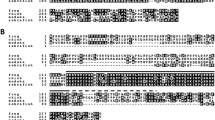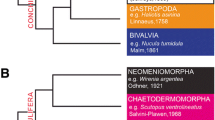Abstract
POU genes play a prominent role in the nervous system differentiation of several organism models, and in particular, they are involved in the differentiation of sensory neurons in numerous invertebrate and vertebrate species. In the present report, cloning and expression profile of a class IV POU gene in amphioxus was assessed for understanding its role in the sensory systems development. A single class IV gene, AmphiPOU-IV was isolated from the amphioxus Branchiostoma floridae. From a phylogenetic point of view, AmphiPOU-IV appears to be strictly related to the vertebrate one, sharing a high homology ratio especially with all vertebrate POU-IV proteins Brn-3a, Brn-3b, and Brn-3c. AmphiPOU-IV was found in the most anterior neural plate and in scattered ectodermic cells on the flanks of neurula, such ectodermic cells resemble the characteristic morphology and position of AmphiCoe and AmphiTrk developing sensory cells. Later on, the expression was confined in some motoneurons at level of the PMC and in some segmental arranged motoneurons in the hindbrain. Such expression is also maintained in larvae, and a new site of AmphiPOU-IV expression was also found in rostrum and mouth edge epidermal sensory cells of the larva. In conclusion, our data suggest an evolutionary conserved role of POU-IV transcription factors in the specification and differentiation of the sensory system in both vertebrates and invertebrates and underline the importance of amphioxus as linking step between them.




Similar content being viewed by others
References
Appel B, Korzh V, Glasgow E, Thor S, Edlund T, Dawid IB, Eisen JS (1995) Motoneuron fate specification revealed by patterned LIM homeobox gene expression in embryonic zebrafish. Development 121:4117–4125
Artinger KB, Fedtsova N, Rhee JM, Bronner-Fraser M, Turner E (1998) Placodal origin of Brn-3-expressing cranial sensory neurons. J Neurobiol 36:572–585
Bardet PL, Schubert M, Horard B, Holland LZ, Laudet V, Holland ND, Vanacker JM (2005) Expression of estrogen-receptor related receptors in amphioxus and zebrafish: implications for the evolution of posterior brain segmentation at the invertebrate-to-vertebrate transition. Evol Dev 7:223–233
Benito-Gutiérrez E, Nake C, Llovera M, Comella JX, Garcia-Fernàndez J (2005) The single AmphiTrk receptor highlights increased complexity of neurotrophin signalling in vertebrates and suggests an early role in developing sensory neuroepidermal cells. Development 132:2191–2202
Budhram-Mahadeo V, Morris PJ, Lakin ND, Theil T, Ching GY, Lillycrop KA, Moroy T, Liem RK, Latchman DS (1995) Activation of the alpha-internexin promoter by the Brn-3a transcription factor is dependent on the N-terminal region of the protein. J Biol Chem 270:2853–2858
Candiani S, Castagnola P, Oliveri D, Pestarino M (2002) Cloning and developmental expression of AmphiBrn1/2/4, a POU III gene in amphioxus. Mech Dev 116:231–234
Candiani S, Pennati R, Oliveri D, Locascio A, Branno M, Castagnola P, Pestarino M, DeBernardi F (2005) Ci-POU-IV expression identifies PNS neurons in embryos and larvae of the ascidian Ciona intestinalis. Dev Genes Evol 215:41–45
Certel SJ, Clyne PJ, Carlson JR, Johnson WA (2000) Regulation of central neuron synaptic targeting by the Drosophila POU protein Acj6. Development 127:2395–2405
Chalfie M, Au M (1989) Genetic control of differentiation of the Caenorhabditis elegans touch receptor neurons. Science 243:1027–1033
DeCarvalho AC, Cappendijk SLT, Fadool JM (2004) Developmental expression of the POU domain transcription factor Brn-3b (Pou4f2) in the lateral line and visual system of Zebrafish. Dev Dyn 229:869–876
Delsuc F, Brinkmann H, Chourrout D, Philippe H (2006) Tunicates and not cephalochordates are the closest living relatives of vertebrates. Nature 439:965–968
Edvardsen RB, Seo HC, Jensen MF, Mialon A, Mikhaleva J, Bjordal M, Cartry J, Reinhardt R, Weissenbach J, Wincker P, Chourrout D (2005) Remodelling of the homeobox gene complement in the tunicate Oikopleura dioica. Curr Biol 15:R12–R13
Erkman L, Yates PA, McLaughlin T, McEvilly RJ, Whisenhunt T, O’Connel SM, Krones AI, Kirby MA, Rapaport DH, Bermingham JR, O’Leary DDM, Rosenfeld MG (2000) A POU domain transcription factor-dependent program regulates axon path finding in the vertebrate visual system. Neuron 28:779–792
Fedtsova N, Turner EE (1995) Brn-3.0 expression identifies early post-mitotic CNS neurons and sensory neural precursors. Mech Dev 53:291–304
Gan L, Xiang M, Zhou L, Wagner DS, Klein WH, Nathans J (1996) POU domain factor Brn-3b is required for the development of a large set of retinal ganglion cells. Proc Natl Acad Sci USA 93:3920–3925
Holland LZ (2005) Non-neural ectoderm is really neural: evolution of developmental patterning mechanisms in the non-neural ectoderm of chordates and the problem of sensory cell homologies. J Exp Zoolog B Mol Dev Evol 304:304–323
Holland LZ, Holland PWH, Holland ND (1996) Revealing homologies between body parts of distantly related animals by in situ hybridization to developmental genes: amphioxus versus vertebrates. In: Ferraris JD, Palumbi SR (eds) Molecular zoology: advances, strategies, and protocols. Wiley, New York, pp 267–282, 473–483
Holland PWH, Holland LZ, Williams NA, Holland ND (1992) An amphioxus homeobox gene: sequence conservation, spatial expression during development and insights into vertebrate evolution. Development 116:653–661
Huang EJ, Zang K, Schmidt A, Saulys A, Xiang M, Reichardt LF (1999) POU domain factor Brn-3a controls the differentiation and survival of trigeminal neurons by regulating Trk receptor expression. Development 126:2869–2882
Jackman WR, Kimmel CB (2002) Coincident iterated gene expression in the amphioxus neural tube. Evol Dev 4:366–374
Jackman WR, Langeland JA, Kimmel CB (2000) islet reveals segmentation in the amphioxus hindbrain homolog. Dev Biol 220:16–26
Lacalli TC, Hou S (1999) A reexamination of the epithelial sensory cells of amphioxus (Branchiostoma). Acta Zool 80:125–134
Lacalli TC, Kelly SJ (1999) Somatic motoneurons in amphioxus larvae: cell types, cell position and innervation patterns. Acta Zool 80:113–124
Lacalli TC, Gilmour THJ, Kelly SJ (1999) The oral nerve plexus in amphioxus larvae: function, cell types and phylogenetic significance. Proc R Soc Lond B 266:1461–1470
Latchman DS (1999) POU family transcription factors in the nervous system. J Cell Physiol 179:126–133
Lee M, Salvaterra PM (2002) Abnormal chemosensory Jump 6 is a positive transcriptional regulator of the cholinergic gene locus in Drosophila olfactory neurons. J Neurosci 22:5291–5299
Liu W, Khare SL, Liang X, Peters MA, Liu X, Cepko CL, Xiang M (2000) All Brn3 genes can promote retinal ganglion cell differentiation in the chick. Development 127:3237–3247
Ma L, Lei L, Eng RS, Turner E, Parada LF (2003) Brn3a regulation of TrkA/NGF receptor expression in developing sensory neurons. Development 130:3525–3534
Mazet F, Masood S, Luke GN, Holland ND, Shimeld SM (2004) Expression of AmphiCoe, an Amphioxus COE/EBF gene, in the developing central nervous system and epidermal sensory neurons. Genesis 38:58–65
McEvilly RJ, Rosenfeld MG (1999) The role of POU domain proteins in the regulation of mammalian pituitary and nervous system development. Prog Nucleic Acid Res Mol Biol 63:223–265
McEvilly RJ, Erkman L, Luo L, Sawchenko PE, Ryan AF, Rosenfeld MG (1996) Requirement for Brn-3.0 in differentiation and survival of sensory and motor-neurons. Nature 384:574–577
O’Brien EK, Degnan BM (2002) Developmental expression of a class IV POU gene in the gastropod Haliotis asinina supports a conserved role in sensory cells development in bilaterians. Dev Genes Evol 212:394–398
Ramachandra NB, Gates RD, Ladurner P, Jacobs DK, Hartenstein V (2002) Embryonic development in the primitive bilaterian Neochildia fusca: normal morphogenesis and isolation of POU genes Brn-1 and Brn-3. Dev Genes Evol 212:55–69
Rowe T (2004) Chordate phylogeny and development. In: Cracraft J, Donoghue MJ (eds) Assembling the tree of life. Oxford University Press, New York, pp 384–409
Ryan AK, Rosenfeld MG (1997) POU domain family values: flexibility, partnerships, and developmental codes. Genes Dev 11:1207–1225
Saitou N, Nei M (1987) The neighbour-joining method: a new method for reconstructing phylogenetic trees. Mol Biol Evol 4:406–425
Satoh G, Wang Y, Zhang P, Satoh N (2001) Early development of amphioxus nervous system with special reference to segmental cell organization and putative sensory cell precursors: a study based on the expression of pan-neuronal marker gene Hu/elav. J Exp Zoolog B Mol Dev Evol 291:354–364
Schubert M, Holland ND, Escriva H, Holland LZ, Laudet V (2004) Retinoic acid influences anteroposterior positioning of epidermal sensory neurons and their gene expression in a developing chordate (amphioxus). Proc Natl Acad Sci USA 101:10320–10325
Seimiya M, Watanabe Y, Kurosawa Y (1997) Identification of POU-class homeobox genes in a freshwater sponge and the specific expression of these genes during differentiation. Eur J Biochem 243:27–31
Shah D, Aurora D, Lance R, Stuart GW (2000) POU genes in metazoans: homologs in sea anemones, snails, and earthworms. DNA Seq 11:457–61
Smith MD, Dawson SJ, Boxer LM, Latchman DS (1998) The N-terminal domain unique to the long form of the Brn-3a transcription factor is essential to protect neuronal cells from apoptosis and for the activation of Bbcl-2 gene expression. Nucleic Acids Res 26:4100–4107
Stach T, Eisler K (1998) The ontogeny of the nephridial system of the larval amphioxus (Branchiostoma lanceolatum). Acta Zool 79:113–118
Stuart GW, Zhu Z, Sampath K, King MW (1995) POU-domain sequences from the flatworm, Dugesia tigrina. Gene 161:299–300
Sze JY, Ruvkun G (2003) Activity of the Caenorhabditis elegans UNC-86 POU transcription factor modulates olfactory sensitivity. Proc Natl Acad Sci USA 100:9560–9565
Theil T, McLean-Hunter S, Zörnig M, Möröy T (1993) Mouse Brn-3 family of POU transcription factors: a new amino terminal domain is crucial for the oncogenic activity of Brn-3a. Nucleic Acids Res 21:5921–5929
Thompson JD, Gibson TJ, Plewniak F, Jeanmougin F, Higgins DG (1997) The CLUSTAL_X windows interface: flexible strategies for multiple sequence alignment aided by quality analysis tools. Nucleic Acids Res 25:4876–4882
Treacy MN, Neilson LI, Turner EE, He X, Rosenfeld MG (1992) Twin of I-POU: a two amino acid difference in the I-POU homeodomain distinguishes an activator from an inhibitor of transcription. Cell 68:491–505
Turner EE, Jenne K, Rosenfeld MG (1994) Brn-3.2: a POU-domain transcription factor with distinctive CNS expression and regulation by retinoic acid. Neuron 12:205–218
van Wijhe JW (1913) On the metamorphosis of Amphioxus lanceolatus. Proc Kon Akad Wetensch (Sci Sect) Sec 16:574–583
Wada H, Garcia-Fernàndez J, Holland PWH (1999) Colinear and segmental expression of amphioxus hox genes. Dev Biol 213:131–141
Xiang M (1998) Requirement for Brn-3b in early differentiation of postmitotic retina ganglion cell precursors. Dev Biol 197:155–169
Xiang M, Zhou L, Macke JP, Yoshioka T, Hendry SH, Eddy RL, Shows TB, Nathans J (1995) The Brn-3 family of POU-domain factors: primary structure, binding specificity and expression in subset of retinal ganglion cells and somatosensory neurons. J Neurosci 15:4762–4785
Xiang M, Gan L, Zhou L, Klein WH, Nathans J (1996) Targeted deletion of the mouse POU domain gene Brn-3a causes selective loss of neurons in the brainstem and trigeminal ganglion, uncoordinated limb movement, and impaired suckling. Proc Natl Acad Sci USA 93:11950–11955
Xiang M, Gan L, Li D, Zhou L, Chen ZY, Wagner D, O’Malley BWJ, Klein W, Nathans J (1997) Role of the Brn-3 family of POU-domain genes in the development of the auditory/vestibular, somatosensory, and visual systems. Cold Spring Harb Symp Quant Biol 62:325–336
Acknowledgements
We thank Skip Pierce and John M. Lawrence (Department of Biology, USF, Tampa, FL, USA) for the use of laboratory space and equipment, Linda Holland (Scripps Institution of Oceanography, La Jolla, CA, USA) for the comments and criticisms, Thomas Stach (Fachbereich Biologie Systematische Zoologie, Berlin, Germany) for the helpful suggestions, and Ray Martinez and Marilyn Wetzel (Department of Biology, USF) for the logistic support. This research was supported by MIUR (FIRB grant RBAU01WAFY_001).
Author information
Authors and Affiliations
Corresponding author
Additional information
Communicated by N. Satoh
Rights and permissions
About this article
Cite this article
Candiani, S., Oliveri, D., Parodi, M. et al. Expression of AmphiPOU-IV in the developing neural tube and epidermal sensory neural precursors in amphioxus supports a conserved role of class IV POU genes in the sensory cells development. Dev Genes Evol 216, 623–633 (2006). https://doi.org/10.1007/s00427-006-0083-6
Received:
Accepted:
Published:
Issue Date:
DOI: https://doi.org/10.1007/s00427-006-0083-6




